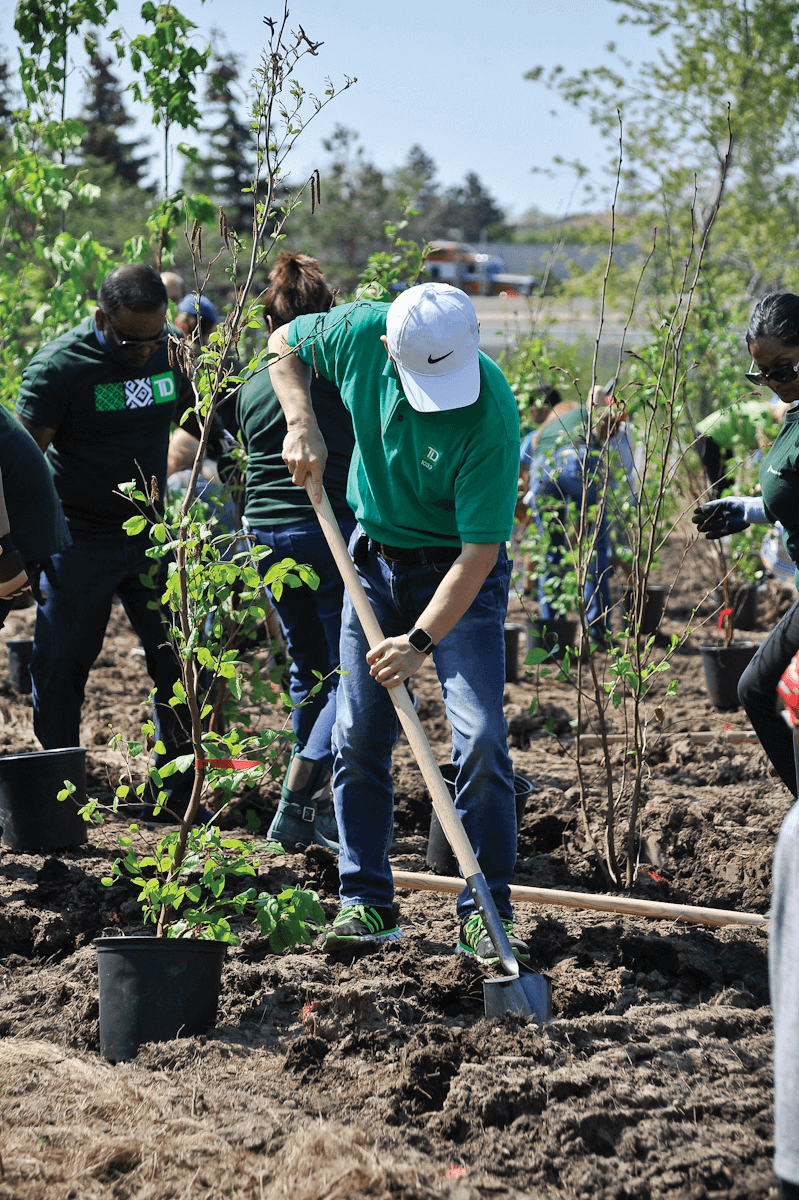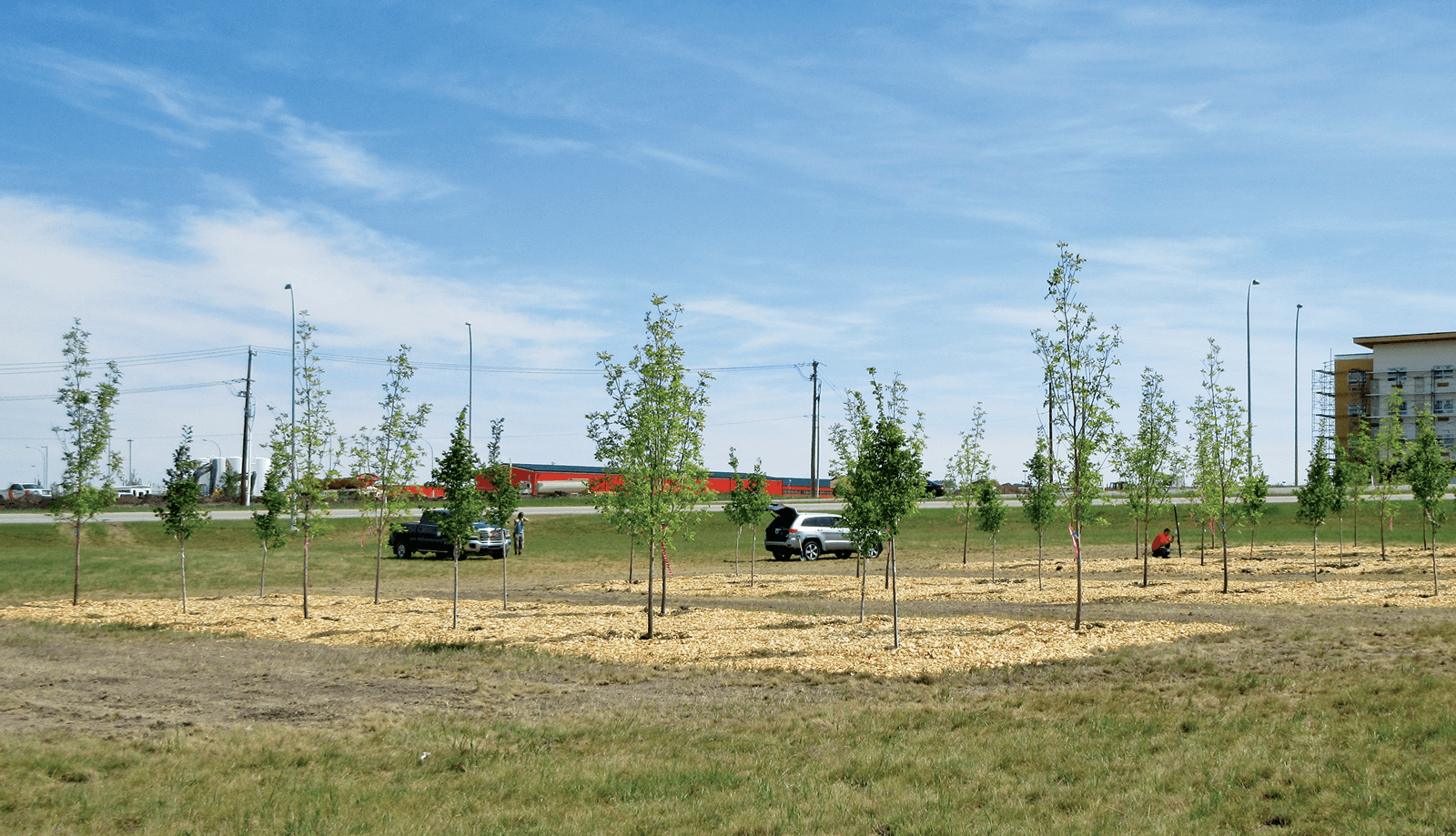April 1, 2019

Greening Canada’s Highways
tree planting research update
BY DR. DARBY McGRATH
Vineland Research and Innovation Centre
Understanding and improving the soil quality of a planting site that has been affected by construction is often critically important to ensure trees can become established. The construction process can significantly alter soil structure and function, as topsoil is removed and stockpiled and heavy equipment compacts sites. Water is the main limiting factor in tree establishment, so in post-construction soils where roots cannot access water and nutrients, trees often do not survive.
On highway roadsides, trees face additional challenges because it is not standard practice to irrigate newly planted trees. Sites are seldom mowed, so trees must compete with ground vegetation for scarce resources. With the support of the Ontario Ministry of Transportation, Landscape Ontario, and the Landscape Alberta Nursery Producers Group, the Greening Canada’s Highways project was initiated to improve tree establishment in highway plantings.
Ontario research trial
In 2014, we began soil remediation research trials in Ontario. The objective of the research was to develop a method for preparing soils that was economically feasible, and created the necessary soil properties trees need to survive and grow. We developed a remediation protocol that uses deep-ripping (fracturing the soil structure) to a depth of 90 cm, followed by application and incorporation of varying amounts of organic amendments into the soil. Using this method, we create a planting bed where drainage is improved, soil is workable and multiple trees can be easily planted together (in contrast to much more labour-intensive tree planting required in compacted soil). The remediated soil, which has been de-compacted and mixed with organic amendment to a depth of nearly 30 cm, promotes a rooting depth adequate for trees, but more importantly, space for roots to expand horizontally. We tested applying compost at 0-, 10-, 25- and 50 per cent rates, on a volume-to-volume basis. This helped us to understand the thresholds of organic matter required to reduce bulk density (compaction) enough to let tree roots grow, while also improving available water holding capacity (plant available water), porosity and nutrient availability in the soils. The treatment where we added 25 per cent compost amended into the soil proved to be the best for tree growth and improved soil quality.
Soil texture, bulk density and organic matter interact to influence water availability. The soil present on planting sites will differ based on these properties. Therefore, we used the trial to help create a soil remediation calculation tool that provides customized recommendations based on soil conditions at the planting site. Users of the tool can take soil samples for organic matter content and texture, and estimate the amount of amendment they will need to add to reduce compaction and improve soil conditions for trees. The soil calculator and a tree species selection tool that is unique to Canada, as well as information on how to sample soils and carry out soil remediation for tree planting, can be found at www.greeningcanadianlandscape.ca.
Soil texture, bulk density and organic matter interact to influence water availability. The soil present on planting sites will differ based on these properties. Therefore, we used the trial to help create a soil remediation calculation tool that provides customized recommendations based on soil conditions at the planting site. Users of the tool can take soil samples for organic matter content and texture, and estimate the amount of amendment they will need to add to reduce compaction and improve soil conditions for trees. The soil calculator and a tree species selection tool that is unique to Canada, as well as information on how to sample soils and carry out soil remediation for tree planting, can be found at www.greeningcanadianlandscape.ca.
 In Ontario, trees are being planted along the Highway 401 corridor from Trenton to the Coroner’s Office in Toronto.
In Ontario, trees are being planted along the Highway 401 corridor from Trenton to the Coroner’s Office in Toronto.
 The Alberta research trial plot located in Airdrie, Alta., at Highway 2 and Veteran’s Boulevard (567).
The Alberta research trial plot located in Airdrie, Alta., at Highway 2 and Veteran’s Boulevard (567).
Alberta research trial
In 2016, we planted separate research trial sites in Edmonton, Calgary and Airdrie, Alta., to build on research findings from Ontario. At these sites we tested different organic amendments that would be available to the local landscape sector. We used municipal compost (comprised of leaf and yard waste, and in Calgary including manure from the Calgary zoo) and composted pulp and paper residuals (waste products that are currently incinerated during the paper-making process). These amendments were incorporated into planting beds and compared alongside trees planted according to the current planting specification of each city. With support from the Landscape Alberta Nursery Producers Group, we are continuing to monitor the trial sites in Alberta for two more growing seasons, but so far the findings from the research trials are promising. Compared to the current municipal planting specification treatment of the trial at each site, tree growth and soil quality have generally been improved in soils that incorporated both municipal compost and the composted pulp and paper residuals.
Putting research in practice — from lab to landscape
Much of the information available about soil quality is based on requirements for producing agricultural crops. For instance, a commonly cited organic matter content goal for agricultural soils is three to five per cent. Although this is a value that reflects the requirements of agricultural crops, it is often the default range used for assessing organic matter content in urban soils for tree planting projects as well. Soils in forest ecosystems resemble neither urban soils nor agricultural soils. They tend to be high in organic matter content, have high water holding capacity, and receive regular inputs of organic matter through fallen wood and leaf litter, resulting in a pool of stored and readily available nutrients, thanks to the myriad actions of soil biota. Therefore, when sampling soils with tree establishment in mind, the soil analysis recommendations available from labs may not accurately reflect improvements needed. It is worth noting that the highway roadside soils possessed soil organic matter contents between 2.5 and four per cent, pre-remediation, but previous tree planting efforts at these sites had not succeeded. The research findings from our project suggest that increasing organic matter content of the planting soil to approximately eight to 10 per cent resulted in the greatest improvement in soil quality and tree growth. In many tree planting projects in urban or semi-urban landscapes, hitting the right levels of increased organic matter would help to reduce compaction and increase water availability for trees.
To help with the hand-off of the research and methods we have developed, we have been working with the Highway of Heroes Living Tribute to design a standard practice for soil preparation and planting. As the Tribute campaign and project continues to roll out planting 117,000 trees along a stretch of Highway 401 between CFB Trenton and the Coroner’s Office in Toronto, it is exciting to see the project findings in action. For more information on the Highway of Heroes Living Tribute visit www.hohtribute.ca.